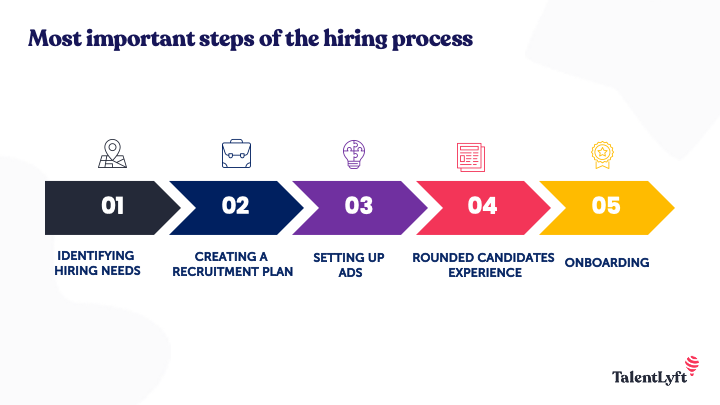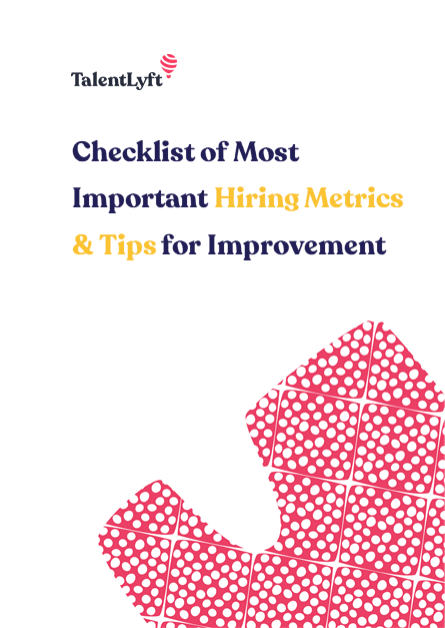![https://adoptoprod.blob.core.windows.net/article/Rx-9Rq1oSUWuqLe59kJ0YQ.png]()
What is a Hiring Process?
The exact definition of a hiring process is following:
“Hiring process refers to the process of finding, selecting and hiring new employees to a company.”
In order for a company to be successful and efficient in performing these three important elements of the hiring process it is important to follow all necessary steps in a coordinated manner. However, before we list all the important steps, we should address some of the most frequent questions regarding the hiring process.
Hiring Process Steps
After you've designed your hiring plan it is time to define the most important steps of the hiring process. Since there are already a number of articles out there with long lists of steps you should follow when hiring a new candidate, in this article we will focus on the five most important steps you should always have in mind.

Create a reliable hiring plan with a free hiring plan template
Enter your desired headcount and yearly hiring budget and receive a detailed hiring plan by departments per year! Download template and optimize your hiring, today!
Create a hiring plan1. Identifying Hiring Needs
The title of this step basically says it all. Before you decide to hire for new positions you should have a clear idea of whether that is because you are filling a newly opened position or you are expanding your business in a certain direction. This decision is ultimately reflected by the needs and requirements of the management of your organization. Therefore, identifying hiring needs ends up being one of the most important elements in your hiring plan.
2. Creating a Recruitment Plan
After carefully examining the needs of your organization and concluding that there is indeed a need for new hires, you should create a detailed recruitment plan. This step, if done correctly, has the power to guide all of the following steps in a systematic and meaningful way. More specifically, creating a detailed recruitment plan will enable you to have a look at the current and future needs of your company and will set up a direction in which your hiring strategy will go to. Within a recruitment plan, you should identify the positions that you wish to hire for, the exact time you wish to have those positions filled, have a notion of how you want to advertise your positions, and finally identify all the steps that your candidates will go through once they express a desire to work for your company.
3. Advertising Plan
One of the most important steps of the hiring process is creating an advertising plan for all the positions that you plan on opening. After you write a compelling job description, it’s time to start advertising! A thorough advertising plan will make sure that you start advertising on time and spread the right messages in order to attract a great number of suitable candidates. Your job ads should be posted on different job boards and social media platforms in order to sufficiently spread your message. Depending on the role you are hiring for, you may consider specialized platforms for each industry. All additional advertising efforts and wisely allocated budgets will reflect on the quality of candidates that will apply for your roles.
4. A Rounded Candidate Experience
Without a standardized hiring procedure and respecting all the steps of the hiring pipeline, it is difficult to have the most efficient and successful hiring possible. Therefore, when hiring new talent, you should definitely create specific pipelines for specific positions or industries you are hiring and offer your candidates the same experience. Such a standardized procedure makes it easier for you to evaluate qualified candidates based on the same criteria and increases candidate experience. Everyone applying for the role at your company can then know what to expect which ultimately reflects on your employer brand as well. Moreover, once you set up all the steps necessary for candidates to go through in order to be hired (one or two interviews, any form of written assessment, and so on), make sure to follow those steps for each and every candidate.
5. Onboarding
Step by step, we reached the final stage of your hiring process is the onboarding process. Once your candidate accepts the offer, you can start with an onboarding. As a part of the onboarding process, the candidate should get to know the culture of the organization he or she is joining, get to know their colleagues, and familiarize themselves with the work that they will be doing. The onboarding process can start from the day your candidate accepts the offer and takes up to a month or two into their work. By providing a mentored and dedicated onboarding experience both you and your new employee get to know each other and are able to manage the expectations.
Lastly, if you wish to see a detailed overview of all steps that you should take when hiring new candidates visit our “What is hiring process”, where we list all the smaller steps in between that would make your hiring the most efficient.
Which Hiring Metrics Do You Need to Optimize Your Hiring Process?
When hiring new talent, besides keeping track of the important steps that should be taken within each recruitment process, hiring managers are equally interested in evaluating important hiring metrics. Without a clear understanding of everything that should be measured within one process, there is no way of adequately evaluating its success. For that reason, we will present some of the most important metrics of the hiring process in the following paragraphs.
1. What is the Difference Between Time-to-Hire and Time-to-Fill?
One of the most frequent confusions we are encountering in terminology is when it comes to defining the difference between time to fill and time to hire. Most importantly, the terms differ in the perspective from which the hiring process is being examined. In other words, time-to-hire refers to the process from the moment a candidate enters the hiring process until they accept the offer. On the other hand, time-to-fill refers to the period that starts with the expressed need of the company to hire a person for a specific position (and a job posting) all until a candidate accepts an offer.
2. How Long Does the Hiring Process Take?
The longevity of each hiring process depends on multiple factors. However, according to a report from Glassdoor Economic Research, the average hiring process in the US takes 23 days. Depending on the industry or the type of role you are applying for, it may take between 12 and 49 days, on average, from the day you started your application until the day you start working.
If you wish to fill in a role that requires less assessment and more practical skills ( such as working in restaurants or bars), the process can be quite fast. However, if your job is in the category of highly skilled management positions, you can expect the process to take up to two months.
3. How to Measure Time-to-Hire?
In order to successfully and precisely measure the cost of your every hire it is important to have a clear understanding of how long it takes you to hire a new employee. Besides the cost of your hiring, it tells you how long on average it takes your HR department to hire. This way you can create and manage specific expectations from everyone working on hiring processes.
Therefore, we present you with the following equations for a successful hiring process.
Time-to-Hire
If we label the day you published your job ad as Day 1, and the candidate that you end up hiring after 30 days, applies to the position on Day 15, the correct way of calculating time-to-hire in this situation becomes 30 - 15 =15 - meaning that time to hire in this case was 15 days.
In other words, time-to-hire for a certain position is calculated by determining the amount of time the position has been open before it got filled, minus the day on which the hired candidate entered your hiring pipeline.
Equation:
Time-to-Hire= Total number of days the position was open - The day that the hired candidate entered the pipeline
Average Time-to-Hire
Furthermore, to get an idea about how long your HR department takes to hire candidates, on average it is useful to calculate the average time-to-hire. By adding a larger number of different times to hire for similar positions and dividing that number by the total number of positions for which you calculated the time to hire, you will get your average value.
More specifically, here is the exact equation:
Average time-to-hire= (Time-to-hire 1 +Time-to-hire 2 + Time-to-hire 3… Time-to-hire N) / N Time-to-Hire
If you wish to explore other hiring metrics, download our free ebook “Checklist of Most Important Hiring Metrics & Tips for Improvement”, and maximize the success of your hiring efforts!

















